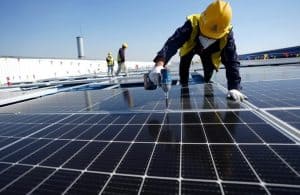
China’s energy storage industry will go from strength to strength in 2023, say analysts, after its leading companies forecast strong earnings amid surging demand from the electric vehicle (EV) sector and as the country rolls out more renewable power projects.
It is estimated that China’s demand for advanced energy storage could surge by roughly 50 per cent to 30 gigawatt-hours (GWh) in 2023, driving global demand to 100GWh.
Shenzhen-listed Sungrow Power Supply, China’s leading energy storage company, estimated late last month that its net profit could have reached 3.2 billion to 3.8 billion yuan (US$560 million) in 2022, double the figure the previous year.
Other major players, including Shanghai-listed Pylon Technologies and GoodWe Power Technology, also posted strong forecasts. Pylon estimated its annual net profit may have reached 1.18 billion to 1.31 billion yuan in 2022, a year-on-year increase of almost 300 per cent.
The robust profit forecasts followed a rapid increase in new energy storage capacity in China in 2022. According to the China Industrial Association of Power Sources (CIAPS), the capacity of advanced energy storage projects put into operation last year was 6.21 gigawatts (GW) / 14.32GWh, a year-on-year increase of about 1.5 times.
Analysts expect the energy storage sector to maintain its momentum in 2023 as China deploys more large-scale renewable energy projects.
“Considering the increased scale of procurement bids for large-scale energy storage projects in 2022, the improved market environment, and the future implementation of more large-scale wind and solar projects which will drive demand for energy storage, we expect the domestic demand for advanced energy storage could reach 30GWh,” said Pi Xiu, and analyst at Ping An Securities, in a report last week.
China, the world’s largest greenhouse gas emitter, aims to develop a new power system that features a higher proportion of renewable energy resources such as wind and solar to support the country’s goal of reaching peak carbon emissions by the end of the decade and net-zero emissions by 2060.
The government wants 80 per cent of the total energy mix to come from non-fossil fuel sources by 2060 and is targeting 1,200GW of solar and wind generation capacity by 2030. China is already the largest producer of solar and wind power, accounting for more than 35 per cent of global capacity.
Energy storage is going to be a crucial part of the country’s new power system, as the electricity generated by wind and solar sources is intermittent and tends to fluctuate with changing weather conditions.
China’s “Big 5” power producers – Huaneng Group, Huadian Group, China Energy Investment Corp (CEIC), State Power Investment Corp (SPIC) and Datang Group – have greatly expanded their storage capacities to around 12.4GW/ 25GWh combined, according to market estimates.
China’s booming EV market is also driving up demand for clean energy storage technologies, such as lithium-ion batteries.
The world’s largest electric car market is aiming for at least 40 per cent of vehicles sold in 2030 to be battery powered, up from about a quarter last year, according to the China Association of Automobile Manufacturers.
It is estimated that mainland Chinese manufacturers will produce about 3,000GWh of EV batteries in 2025, according to a report by the Economic Daily, a newspaper run by the State Council.
According to CIAPS, there were 259 energy storage projects operating in China last year, with a combined capacity of 20.75GW. The energy storage sector is expected to maintain an annual growth rate of 55 to 70 per cent in the five years from 2021 to 2025.
“The rush to install photovoltaics in China in late 2022 drove the high-speed growth of energy storage systems … meanwhile, the price cuts in the lithium battery material supply chain also brought down costs for storage systems,” said Dong Haijun, an analyst at Beijing-based Capital Securities, in a report last week.
“We estimate the global energy storage market could reach 100GWh in 2023, an increase of about 100 per cent.”
